Items
Tag
Identity
-
 Community of Song: Latin Music in Sharing Identity and Promoting Cultural Humility In this video, Colombian-Canadian singer-songwriter Gerry Rozo, through a retelling of his personal experiences, explores the role of music in cultural identity and community-building. He discusses his journey to Canada, the progression of his music career, his thoughts on cultural humility in Canadian society, and the ways in which he believes music can be a conduit for both the preservation of cultural identity and promotion of intercultural communication.
Community of Song: Latin Music in Sharing Identity and Promoting Cultural Humility In this video, Colombian-Canadian singer-songwriter Gerry Rozo, through a retelling of his personal experiences, explores the role of music in cultural identity and community-building. He discusses his journey to Canada, the progression of his music career, his thoughts on cultural humility in Canadian society, and the ways in which he believes music can be a conduit for both the preservation of cultural identity and promotion of intercultural communication. -
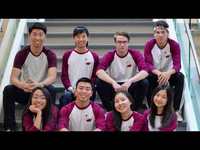 Negotiating a Bi-cultural Identity: An Interview with Andy Fuchigami The video features an interview with Andy Fuchigami, a Canadian-born member of the Japanese community in London. He grew up in a North American cultural environment, which resulted in him negotiating between two very different cultural identities. The video focuses on his feelings and experiences as a minority at school, leading to his struggle in accepting his Japanese identity. He explains how he avoided making Japanese friends, speaking in Japanese, and even trying to hide his Japanese name. However, Andy’s views have now totally shifted, and he has completely embraced his Japanese cultural identity, owing to some life experiences he has had. He went from having only Caucasian friends to making more Japanese friends, and he now actively participates in Japanese cultural activities in London.
Negotiating a Bi-cultural Identity: An Interview with Andy Fuchigami The video features an interview with Andy Fuchigami, a Canadian-born member of the Japanese community in London. He grew up in a North American cultural environment, which resulted in him negotiating between two very different cultural identities. The video focuses on his feelings and experiences as a minority at school, leading to his struggle in accepting his Japanese identity. He explains how he avoided making Japanese friends, speaking in Japanese, and even trying to hide his Japanese name. However, Andy’s views have now totally shifted, and he has completely embraced his Japanese cultural identity, owing to some life experiences he has had. He went from having only Caucasian friends to making more Japanese friends, and he now actively participates in Japanese cultural activities in London. -
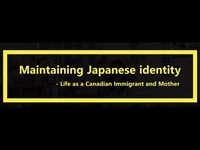 Maintaining Japanese identity: Life as a Canadian immigrant and Mother The video explores the life of Chigusa Peters who is a new Japanese immigrant to London, Ontario and also a mother of three daughters. During the interview, Chigusa first talks about her own identity and the difficulties she encountered in adapting to Canadian culture. She also discusses the differences between life in Canada and life in Japan. In the hopes of passing on Japanese traditions to her daughters, she takes them to karate classes every Monday and Wednesday, and to the Japanese language school every Saturday morning. The video ends with her talking about which aspects of Japanese culture she hopes her kids will be able to learn through these activities.
Maintaining Japanese identity: Life as a Canadian immigrant and Mother The video explores the life of Chigusa Peters who is a new Japanese immigrant to London, Ontario and also a mother of three daughters. During the interview, Chigusa first talks about her own identity and the difficulties she encountered in adapting to Canadian culture. She also discusses the differences between life in Canada and life in Japan. In the hopes of passing on Japanese traditions to her daughters, she takes them to karate classes every Monday and Wednesday, and to the Japanese language school every Saturday morning. The video ends with her talking about which aspects of Japanese culture she hopes her kids will be able to learn through these activities. -
 I Am Not Just "The Girl From Bolivia": An International Student’s Experiences of Community in Bolivia and London This portrait delves into Maya Fernandez's story of being known as “the girl from Bolivia." The portrait illustrates Maya’s feelings towards this phrase and how her experiences “as an outsider” have impacted her experiences in the London community. Maya is a second year MIT international student at Western University who explores the certain interactions that she has faced. She then compares how relationships are developed in both Bolivia and London. She explains the social inequalities that she has observed, the stereotypes of being from another country, and what it’s like to be “an outsider" in London, Ontario. Overall, this portrait thoroughly describes Maya for the complex and unique being that she is, rather than just as “the girl from Bolivia.”
I Am Not Just "The Girl From Bolivia": An International Student’s Experiences of Community in Bolivia and London This portrait delves into Maya Fernandez's story of being known as “the girl from Bolivia." The portrait illustrates Maya’s feelings towards this phrase and how her experiences “as an outsider” have impacted her experiences in the London community. Maya is a second year MIT international student at Western University who explores the certain interactions that she has faced. She then compares how relationships are developed in both Bolivia and London. She explains the social inequalities that she has observed, the stereotypes of being from another country, and what it’s like to be “an outsider" in London, Ontario. Overall, this portrait thoroughly describes Maya for the complex and unique being that she is, rather than just as “the girl from Bolivia.” -
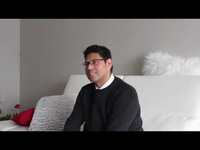 Breaking Boundaries: From Guatemala to Canada. How we share similarities, regardless of location. In this portrait, Juan Carlos Parada explains his definition of culture and provides his audience with anecdotal references to create a vibrant portrayal of his cultural background. Reminiscing on his immigration to Canada, Juan Carlos tackles the hardships of being a minority experienced by both himself and his parents. He points out his core belief of how although each culture may have superficial differences, once one looks past those differences, every individual has similarities that bring them together. In addition, Juan Carlos opens up about misconceptions associated with his culture, based on his own experiences, and concludes his story with ways to overcome stigmas. In conclusion, although Juan Carlos narrates this story through his own experiences, this portrait is one that can resonate with many people once they seek to look past differences.
Breaking Boundaries: From Guatemala to Canada. How we share similarities, regardless of location. In this portrait, Juan Carlos Parada explains his definition of culture and provides his audience with anecdotal references to create a vibrant portrayal of his cultural background. Reminiscing on his immigration to Canada, Juan Carlos tackles the hardships of being a minority experienced by both himself and his parents. He points out his core belief of how although each culture may have superficial differences, once one looks past those differences, every individual has similarities that bring them together. In addition, Juan Carlos opens up about misconceptions associated with his culture, based on his own experiences, and concludes his story with ways to overcome stigmas. In conclusion, although Juan Carlos narrates this story through his own experiences, this portrait is one that can resonate with many people once they seek to look past differences. -
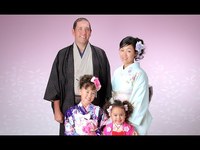 Integrating Japanese Culture into Canada In this portrait, Keiko Yano talks about the different aspects of the Japanese culture being adapted to Canada such as Girl’s Day and tea ceremony. She explains her participation in the community and her wish to keep the culture alive within her daughters. Keiko’s daughter, Erika, then briefly explains why she continues to learn the Japanese language. After that Keiko’s husband, Chris, describes the significance of Buddhism practices to him and discusses the activeness of the Japanese community in London. The portrait then ends with Keiko expressing her renewal of self and deeper appreciation in the Japanese culture by coming to Canada.
Integrating Japanese Culture into Canada In this portrait, Keiko Yano talks about the different aspects of the Japanese culture being adapted to Canada such as Girl’s Day and tea ceremony. She explains her participation in the community and her wish to keep the culture alive within her daughters. Keiko’s daughter, Erika, then briefly explains why she continues to learn the Japanese language. After that Keiko’s husband, Chris, describes the significance of Buddhism practices to him and discusses the activeness of the Japanese community in London. The portrait then ends with Keiko expressing her renewal of self and deeper appreciation in the Japanese culture by coming to Canada. -
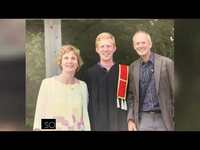 Raising Children in a German-Canadian Household: The Importance of Language and Culture This portrait follows the life of a German woman, Kordula, who immigrated to southwestern Ontario in 1999 in order to farm. The portrait specifically focuses on her journey in raising her children in a German-Canadian household. The portrait captures how she tried to preserve German traditions and the German language while raising her children amidst the backdrop of southwestern Ontario. It touches on why language is important to her and her children’s upbringing, indicating that it has allowed them to foster their German-Canadian identity. She also gives advice for families who have immigrated, and wish to continue teaching their children about their culture.
Raising Children in a German-Canadian Household: The Importance of Language and Culture This portrait follows the life of a German woman, Kordula, who immigrated to southwestern Ontario in 1999 in order to farm. The portrait specifically focuses on her journey in raising her children in a German-Canadian household. The portrait captures how she tried to preserve German traditions and the German language while raising her children amidst the backdrop of southwestern Ontario. It touches on why language is important to her and her children’s upbringing, indicating that it has allowed them to foster their German-Canadian identity. She also gives advice for families who have immigrated, and wish to continue teaching their children about their culture. -
 Seeing the World Through a Colombian Lens: Travel Stories from Roberto Mocetón Roberto Mocetón shares the cultural importance of travel in Colombia. He reflects on his motivations for personal travel after moving from Bogotá, Colombia to London, Canada with his family. Roberto views travelling as an opportunity to connect with his family, become more globally-minded, and pass along these values with his son. He highlights that travel is a way for us to learn from and connect with others. In this video, he also reflects on the similarities and differences between the role of travel in Colombian and Canadian cultures.
Seeing the World Through a Colombian Lens: Travel Stories from Roberto Mocetón Roberto Mocetón shares the cultural importance of travel in Colombia. He reflects on his motivations for personal travel after moving from Bogotá, Colombia to London, Canada with his family. Roberto views travelling as an opportunity to connect with his family, become more globally-minded, and pass along these values with his son. He highlights that travel is a way for us to learn from and connect with others. In this video, he also reflects on the similarities and differences between the role of travel in Colombian and Canadian cultures. -
 An Identity of Work: The Importance of Work and Family in the Life of an Arabic Canadian Immigrant The story of an Arabic Canadians journey in immigrating, finding employment, and regaining his identity in his chosen line of work, This is a portrait which demonstrates the struggles new immigrants face, the highs and lows of moving countries and being in new cultural contexts, and how identity can be lost and found in the work that we do. Through the lens of this portrait can be seen the truth of what it is like to search out opportunity and work hard for a dream that many Canadian citizens share: to do what you love with those you love in a place where you feel secure and happy.
An Identity of Work: The Importance of Work and Family in the Life of an Arabic Canadian Immigrant The story of an Arabic Canadians journey in immigrating, finding employment, and regaining his identity in his chosen line of work, This is a portrait which demonstrates the struggles new immigrants face, the highs and lows of moving countries and being in new cultural contexts, and how identity can be lost and found in the work that we do. Through the lens of this portrait can be seen the truth of what it is like to search out opportunity and work hard for a dream that many Canadian citizens share: to do what you love with those you love in a place where you feel secure and happy. -
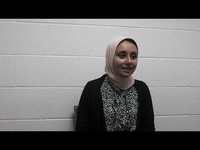 Exploring Multiculturalism as a way of life This portrait follows the story of Marwa Ali, a German teacher in London, Ontario. She was born in Egypt, where she spent her childhood, and had the opportunity to attend a German school. In this video she talks about what her experience has been coming to Canada and how growing up with the Egyptian and German cultures has affected her mindset. After a break, she is now living again in Canada and will explain how her multiculturalism has been an asset and how open-mindedness is important in our modern life.
Exploring Multiculturalism as a way of life This portrait follows the story of Marwa Ali, a German teacher in London, Ontario. She was born in Egypt, where she spent her childhood, and had the opportunity to attend a German school. In this video she talks about what her experience has been coming to Canada and how growing up with the Egyptian and German cultures has affected her mindset. After a break, she is now living again in Canada and will explain how her multiculturalism has been an asset and how open-mindedness is important in our modern life. -
 From the Manizales Home to the London Home: A Youth's Story of Immigrating from Colombia to Canada This portrait features an interview with Juan Gaviria. During this interview, he shares stories about his experiences of moving from Colombia to Canada as a youth with his family. Juan also shares his opinions on “what makes a home”. Juan talks about how he believes Colombia and Canada are both home to him, yet, he feels many differences between his two homes. In addition, Juan has also shared some specific stories about the challenges he has faced during his process of making London his new home as well as some of his heartwarming encounters in the London Latino-Canadian Community, that have helped to minimize these challenges for him. At the end of the video, Juan shares some examples of the events and activities in London that remind him of his heritage culture and his Colombia home. Juan’s sense of “home” indicates his sense of belonging to his new community. This also marks that his journey of settling in London has shaped his new identity as a Latino-Canadian. In addition, his stories have vividly illustrated the importance and impacts of cultural humility and have demonstrated how an understanding of only the surface culture without an understanding of the deep culture can cause misunderstandings and lack of respect among individuals who have different cultural backgrounds.
From the Manizales Home to the London Home: A Youth's Story of Immigrating from Colombia to Canada This portrait features an interview with Juan Gaviria. During this interview, he shares stories about his experiences of moving from Colombia to Canada as a youth with his family. Juan also shares his opinions on “what makes a home”. Juan talks about how he believes Colombia and Canada are both home to him, yet, he feels many differences between his two homes. In addition, Juan has also shared some specific stories about the challenges he has faced during his process of making London his new home as well as some of his heartwarming encounters in the London Latino-Canadian Community, that have helped to minimize these challenges for him. At the end of the video, Juan shares some examples of the events and activities in London that remind him of his heritage culture and his Colombia home. Juan’s sense of “home” indicates his sense of belonging to his new community. This also marks that his journey of settling in London has shaped his new identity as a Latino-Canadian. In addition, his stories have vividly illustrated the importance and impacts of cultural humility and have demonstrated how an understanding of only the surface culture without an understanding of the deep culture can cause misunderstandings and lack of respect among individuals who have different cultural backgrounds. -
 Maintaining & Sharing your Cultural Identity: Through Education, Exposure, & Experience The video explores the cultural identity of Jose. A. Casanova, with a particular focus on how food serves as reminder of where he has come from. We not only talk about how food has shaped who he is today, but also the people who have influenced him significantly, including his mother. Over time, his core values have not diminished despite a change in location. Through passing on values from his Venezuelan culture and his wife’s Colombian culture to his children, he actively encourages them to be culturally humble and to embrace their diverse cultural identity. He does this by emphasizing that they are not just from one community, but they are from three: Canadian, Venezuelan and Colombian. He provides advice on the best way to preserve one’s cultural identity, so that one can maintain one’s roots and not forget where one has come from. He also stresses on the importance of helping others because having gone through the challenges that come with being a new immigrant in Canada himself, he realizes a little help can go a long way.
Maintaining & Sharing your Cultural Identity: Through Education, Exposure, & Experience The video explores the cultural identity of Jose. A. Casanova, with a particular focus on how food serves as reminder of where he has come from. We not only talk about how food has shaped who he is today, but also the people who have influenced him significantly, including his mother. Over time, his core values have not diminished despite a change in location. Through passing on values from his Venezuelan culture and his wife’s Colombian culture to his children, he actively encourages them to be culturally humble and to embrace their diverse cultural identity. He does this by emphasizing that they are not just from one community, but they are from three: Canadian, Venezuelan and Colombian. He provides advice on the best way to preserve one’s cultural identity, so that one can maintain one’s roots and not forget where one has come from. He also stresses on the importance of helping others because having gone through the challenges that come with being a new immigrant in Canada himself, he realizes a little help can go a long way. -
 Aldo at the Marconi Club: A Portrait of Italian-Canadian Identity in London This portrait is based around Aldo, an Italian-Canadian member of the London community. Aldo visits the Marconi Club, an enduring and popular meeting place and events hall for Italians in London. We follow Aldo through different parts of the building, and learn a little about the club’s activities and how the Club has been important to Aldo in his life. Aldo then answers questions about his childhood, his Italian-Canadian identity, and his desire to maintain his Italian language proficiency.
Aldo at the Marconi Club: A Portrait of Italian-Canadian Identity in London This portrait is based around Aldo, an Italian-Canadian member of the London community. Aldo visits the Marconi Club, an enduring and popular meeting place and events hall for Italians in London. We follow Aldo through different parts of the building, and learn a little about the club’s activities and how the Club has been important to Aldo in his life. Aldo then answers questions about his childhood, his Italian-Canadian identity, and his desire to maintain his Italian language proficiency. -
 Fostering a Sense of Community: An Immigration Story An Immigration Story
Fostering a Sense of Community: An Immigration Story An Immigration Story -
 Exploring Connection and Disconnection to self with Dual Cultural Identities: Canadian and Italian The video is focused on the story of John and Marie Meren who are the children of Italian immigrants. John with both of his parents being from Sardinia and Marie being half Canadian. It Starts with brief overview of John’s parent’s immigration story, highlighting where they were from and their motivation to move to Canada (work opportunities). Next the video moves on to focus on John and Marie’s experiences, and how they negotiated their identities in relation to their Canadian and Italian mix. John discusses the languages he was raised with (Italian, Sardinian and English) and Marie explains why she always felt more Canadian and the reasons why she never learnt Italian. They explain how world events like WW2 led to their disconnection from their being Italian at some points. John connects his job as a lawyer and to his Italian heritage. Finally, they talk about the trip they took to Italy and how it impacted them and helped to define their connection with being Italian
Exploring Connection and Disconnection to self with Dual Cultural Identities: Canadian and Italian The video is focused on the story of John and Marie Meren who are the children of Italian immigrants. John with both of his parents being from Sardinia and Marie being half Canadian. It Starts with brief overview of John’s parent’s immigration story, highlighting where they were from and their motivation to move to Canada (work opportunities). Next the video moves on to focus on John and Marie’s experiences, and how they negotiated their identities in relation to their Canadian and Italian mix. John discusses the languages he was raised with (Italian, Sardinian and English) and Marie explains why she always felt more Canadian and the reasons why she never learnt Italian. They explain how world events like WW2 led to their disconnection from their being Italian at some points. John connects his job as a lawyer and to his Italian heritage. Finally, they talk about the trip they took to Italy and how it impacted them and helped to define their connection with being Italian -
 A Mixture of Cultures: A Story of Nationality The portrait project begins with a description of Hugo discussing his immigration from the Netherlands to Canada. The video then transitions to a discussion about the German Canadian Club while footage of the Club's 2018 Christmas Market is shown. The dialogue of the German Canadian Club discussion relates to the various types of things offered at the club, as well as the reasons as to why it was formed. Finally, the video concludes as Hugo discusses how the migration from the Netherlands to Canada has impacted his identity.
A Mixture of Cultures: A Story of Nationality The portrait project begins with a description of Hugo discussing his immigration from the Netherlands to Canada. The video then transitions to a discussion about the German Canadian Club while footage of the Club's 2018 Christmas Market is shown. The dialogue of the German Canadian Club discussion relates to the various types of things offered at the club, as well as the reasons as to why it was formed. Finally, the video concludes as Hugo discusses how the migration from the Netherlands to Canada has impacted his identity.